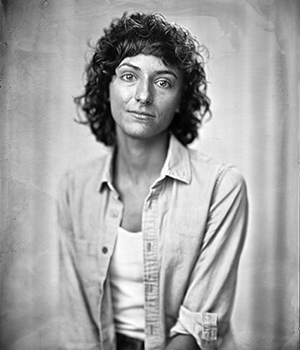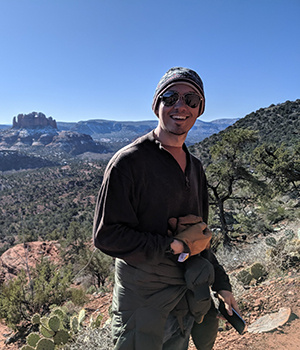Alicia Lamarche, 2020 Ph.D., is the first UofSC graduate to earn the honor, and Keller VandeBogert, 2021 Ph.D., is among the most recent recipients of the fellowships, which support future leaders in mathematics and statistics.
From the thousands of potential applicants for the fellowships, the NSF selects only about 30. Having two recent graduates receive these fellowships is exciting for Professor Matthew Ballard, who served as a dissertation advisor to both Lamarche and VandeBogert. “It reflects the strong research leadership of the South Carolina algebra, geometry and number theory group,” says Ballard.
Artistic expression, by the numbers
When Alicia Lamarche works out a problem, she sits down with pencil and paper or gets together with colleagues in front of a chalkboard. She writes and draws pictures, conceptualizing highly complex algebraic geometry.
“I’d like to think of it like a painter’s studio,” Lamarche says. “It’s mostly a bit messy with poorly drawn sketches of things, dried paint splatters and rough drafts strewn about, but somewhere in the mix there’s something good hiding. It’s a lot of fun.”
Lamarche is currently helping organize the University of Utah’s Algebraic Geometry Seminar and working on her research. She studies algebraic geometry questions in nonzero characteristics, aiming “to answer a very basic albeit a very difficult question: Does this set of equations have a solution?”
Drawing her work is practically an impossible task. Algebraic varieties can be difficult to conceptualize as a geometric object, with incredible levels of complexity, Lamarche says. “They can ‘live’ inside of high-dimensional space in such a way that we have no means of visualizing it, but this is where algebra becomes helpful!”
Using algebra, Lamarche analyzes data sets to understand objects that could not possibly exist in our world. Imagine something that exists in four dimensions — or six, eight or even 500 dimensions. She says the data sets themselves, called derived categories, can be infinitely complex.
“I anticipate working on these things indefinitely,” Lamarche says. “I have research questions that I don’t ever expect to answer, but I will think about them nonetheless.”
She remembers when algebra seemed elusive. “In high school, I started off in the remedial algebra class because I was considered unprepared for Algebra 1,” she says. As she advanced in her studies, she took an interest in the more abstract elements, like an image of a Mandelbrot set she saw in a textbook.
“I was really interested in art, so I’d already seen fractal geometry from an artistic or philosophical perspective,” Lamarche says, “and this made me really interested in what was going on mathematically.”
Before coming to UofSC, she majored in mathematics and did research on number theory at Shippensburg University. In her first semester in graduate school at UofSC, Lamarche took a course with Ballard, and she felt it was the hardest class she’d ever taken. Ballard counseled her to start asking more questions.
“I went to any office hour I could, I even bothered him if I saw him walking on the street,” Lamarche says. “He never gave me direct answers but instead helped me work through and think about problems. This is when I felt like I really started to understand the material.”
Lamarche is working to build on the foundation of her dissertation work, her curiosity ever present as she pursues more unanswered questions. “I hope that someone will find my work interesting,” she says.
She also hopes to pass down her love of complex math to the next generation and help change the culture of mathematics research to be more inclusive.
“I hear a lot of students say they’re ‘not a math person,’” Lamarche says. “This is precisely what I hope to change; I’d like to help people use mathematics as a means of empowerment.”
“What drew me to the forefront of mathematical research was a series of wonderfully kind teachers and professors who believed in me even when I didn’t believe in myself.”
Breaking it down to the elements
Another recent graduate of UofSC, Keller VandeBogert is now the Kenna Visiting Assistant Professor at University of Notre Dame. VandeBogert’s tools are a laptop or tablet and, like Lamarche, computer software for checking computations beyond human abilities.
He studies commutative algebra, representation theory/combinatorics and algebraic geometry, and he compares his goal in mathematics to the efforts of chemists who worked to classify atoms in the periodic table of elements, “albeit for much more abstract families of objects.”
He explains that “mathematics long ago realized that many objects in nature are simple at the local level but may be much more complicated when viewed from a different perspective. Think about how the Earth looks totally flat to a human standing on the surface.”
“That is what I do,” says VandeBogert, “I like to take mathematically complicated objects and break them down to much simpler pieces.”
His work involves constructing something called a free resolution, which provides mathematical instructions on how to break apart and reassemble a more complicated object — like the atoms that make up the physical world.
Another example is to think of a blacksmith making all sorts of different tools out of a piece of metal, which could be thought of as the very same object but with different properties retained. “This reduces a seemingly infinite problem into a finite problem,” VandeBogert says.
Making progress in mathematical research can be slow-going or at other times come quickly with a breakthrough. He says the key is to be consistently engaged.
“This doesn’t mean that you are always happy, but rather that you can’t think of anything else that would be more meaningful to you,” VandeBogert says.
Both Lamarche and VandeBogert express a joy for their work in and of itself and hope that others will find it useful.
“I would be even happier if the work I do provides some sort of infrastructure for other mathematicians to build on,” VandeBogert says, "or provides a connection between areas of mathematics that were previously viewed as unrelated.”
The NSF fellowships offer a rare opportunity to focus on research and establish Lamarche and VandeBogert as mathematicians to watch.
“The prestige, resources and mentorship are all incredible benefits,” Ballard says. “It was clear from the beginning that both Alicia and Keller are very talented. I expect them to make full use of this opportunity to springboard to even greater things.”


